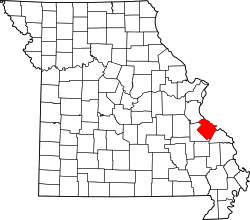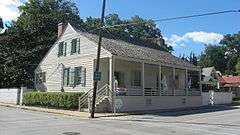National Register of Historic Places listings in Ste. Genevieve County, Missouri

Location of Ste. Genevieve County in Missouri
This is a list of the National Register of Historic Places listings in Ste. Genevieve County, Missouri.
This is intended to be a complete list of the properties and districts on the National Register of Historic Places in Ste. Genevieve County, Missouri, United States. Latitude and longitude coordinates are provided for many National Register properties and districts; these locations may be seen together in a map.[1]
There are 5 properties and districts listed on the National Register in the county, including 2 National Historic Landmarks.
- This National Park Service list is complete through NPS recent listings posted December 16, 2016.[2]
Current listings
| [3] | Name on the Register | Image | Date listed[4] | Location | City or town | Description |
|---|---|---|---|---|---|---|
| 1 | Louis Bolduc House |  |
(#69000305) |
123 S. Main St. 37°59′21″N 90°03′13″W / 37.989167°N 90.053611°W |
Ste. Genevieve | |
| 2 | Common Field Archeological Site |  |
(#69000306) |
Northern side of Cotton Woods Rd., east of its junction with U.S. Route 61[5]:8 37°57′22″N 90°00′50″W / 37.956111°N 90.013889°W |
Ste. Genevieve | |
| 3 | Jacques Dubreuil Guibourd House |  |
(#69000307) |
Northwestern corner of 4th and Merchant Sts. 37°58′46″N 90°02′52″W / 37.979444°N 90.047778°W |
Ste. Genevieve | |
| 4 | Kreilich Archeological Site |  |
(#69000308) |
Along U.S. Route 61 at the junction of Saline Creek and the old Mississippi River bed[6]:27 37°54′03″N 89°58′34″W / 37.900833°N 89.976111°W |
Ste. Genevieve | |
| 5 | Ste. Genevieve Historic District |  |
(#66000892) |
Address unknown at this time; also roughly bounded by Main St. and St. Mary's Rd., Roberts, 7th, and Seraphin Sts. 37°58′44″N 90°02′35″W / 37.978889°N 90.043111°W |
Ste. Genevieve | Second set of boundaries represents a boundary increase of April 11, 2002 |
See also
- List of National Historic Landmarks in Missouri
- National Register of Historic Places listings in Missouri
References
| Wikimedia Commons has media related to National Register of Historic Places in Ste. Genevieve County, Missouri. |
- ↑ The latitude and longitude information provided in this table was derived originally from the National Register Information System, which has been found to be fairly accurate for about 99% of listings. For about 1% of NRIS original coordinates, experience has shown that one or both coordinates are typos or otherwise extremely far off; some corrections may have been made. A more subtle problem causes many locations to be off by up to 150 yards, depending on location in the country: most NRIS coordinates were derived from tracing out latitude and longitudes off of USGS topographical quadrant maps created under the North American Datum of 1927, which differs from the current, highly accurate WGS84 GPS system used by most on-line maps. Chicago is about right, but NRIS longitudes in Washington are higher by about 4.5 seconds, and are lower by about 2.0 seconds in Maine. Latitudes differ by about 1.0 second in Florida. Some locations in this table may have been corrected to current GPS standards.
- ↑ "National Register of Historic Places: Weekly List Actions". National Park Service, United States Department of the Interior. Retrieved on December 16, 2016.
- ↑ Numbers represent an ordering by significant words. Various colorings, defined here, differentiate National Historic Landmarks and historic districts from other NRHP buildings, structures, sites or objects.
- ↑ The eight-digit number below each date is the number assigned to each location in the National Register Information System database, which can be viewed by clicking the number.
- ↑ Milner, George R. "The Late Prehistoric Cahokia Cultural System of the Mississippi River Valley: Foundations, Florescence, and Fragmentation". Journal of World Prehistory 4.1 (1990): 1-43.
- ↑ Keslin, Richard. "Archaeological Implications on the Role of Salt as an Element of Cultural Diffusion." Missouri Archaeologist 26 (1964): 1-181.
This article is issued from Wikipedia - version of the 6/19/2016. The text is available under the Creative Commons Attribution/Share Alike but additional terms may apply for the media files.